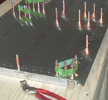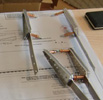


random user submitted photo
Nose "heavy"
Re: Nose "heavy"
If you're confident the wing incidence is correct, I would take a close look at the engine thrust line.
- Area 51%
- Posts: 747
- Joined: Thu Feb 18, 2016 7:57 am
Re: Nose "heavy"
T41pilot/Bryan C,
Very interesting - I have been working on the plans instructions; while keeping the control stick(s) vertical in a "jig", placing a straight edge on the aileron and measuring the "gap" at the wing spare positions. I then adjusted the flaps to the ailerons.
By any chance do you have a flap to spare gap measurement.
Very interesting - I have been working on the plans instructions; while keeping the control stick(s) vertical in a "jig", placing a straight edge on the aileron and measuring the "gap" at the wing spare positions. I then adjusted the flaps to the ailerons.
By any chance do you have a flap to spare gap measurement.
- Skippydiesel
- Posts: 666
- Joined: Tue Jul 06, 2021 6:24 am
Re: Nose "heavy"
Area 51% wrote:If you're confident the wing incidence is correct, I would take a close look at the engine thrust line.
Full disclosure; This Sonex has had its wing/horizontal stabiliser, angle of attack increased by 1.6 degrees from factory/plans specifications.
Engine thrust line is defined by Sonex (factory) engine frame, with latest Sonex/Rotax "bed" adapter - I would hope that this would be well within design parameters.
- Skippydiesel
- Posts: 666
- Joined: Tue Jul 06, 2021 6:24 am
Re: Nose "heavy"
Skippydiesel wrote:T41pilot/Bryan C,
Very interesting - I have been working on the plans instructions; while keeping the control stick(s) vertical in a "jig", placing a straight edge on the aileron and measuring the "gap" at the wing spare positions. I then adjusted the flaps to the ailerons.
By any chance do you have a flap to spare gap measurement.
The "B" model plans have you rig the ailerons and flaps separately using the same process though with a straight edge and dimension above the spar to the bottom of the straight edge. I would not pick one thing and rig it and then set the trailing edge of the other thing to match. I started with ailerons with my stick centered and completed the process in the plans. Fore and aft of the stick did not apply since the elevator was not involved. Took some back and forth on each side until I thought it was right. Then rigged the flaps using the same process. I then checked to see if all trailing edges matched. It took me 2 or 3 tries through the whole process but finally got that to happen. I was confident at that point that was the best the rigging was ever going to get. A small adjustment on a given linkage would yield a significant change on the spar to straight edge measurement so hence the multiple tries.
Gregg Kaat
Sonex B #0014
Sonex B #0014
- T41pilot
- Posts: 138
- Joined: Sat Nov 26, 2016 3:57 pm
- Location: Howard City, Michigan
Re: Nose "heavy"
My method was;
Since the above done and aircraft flown, left flap adjusted up to reduce slight tendency to role to right. Test flight, on last adjustment, yet to be done.
[list=]I only had the one location (on each aileron) - perhaps I should have repeated along entire length.
I did not go through this procedure for the flaps, instead using the aileron to provide the correct alignment - perhaps I should have repeated repeated the procedure for the flaps.[/list]
- Construct & install a frame to securely "lock" the control columns at 90 degrees.
Make a 74mm measure, with feet, that will reliably sit at/in the same vertical plain for each aileron over several repeat measurements/adjustments.
Using a piece of angle aluminium, as the strait edge, aligning with the same line of rivets for each aileron/wing, place 74 mm measure on edge of upper wing skin/over spar, adjust aileron to measure.
Adjust flaps to aileron.
Since the above done and aircraft flown, left flap adjusted up to reduce slight tendency to role to right. Test flight, on last adjustment, yet to be done.
[list=]I only had the one location (on each aileron) - perhaps I should have repeated along entire length.
I did not go through this procedure for the flaps, instead using the aileron to provide the correct alignment - perhaps I should have repeated repeated the procedure for the flaps.[/list]
- Skippydiesel
- Posts: 666
- Joined: Tue Jul 06, 2021 6:24 am
Re: Nose "heavy"
Skippydiesel wrote:...
Full disclosure; This Sonex has had its wing/horizontal stabiliser, angle of attack increased by 1.6 degrees from factory/plans specifications.
? Is this a common modification ? I can imagine this to be helpful for shorter takeoffs and better vsby on landing flair. What else does this accomplish?
-Brock
Sonex-A (s/n 1013)
R2300, P-tip 54/50
Center Stick
V16, TT22
Sonex-A (s/n 1013)
R2300, P-tip 54/50
Center Stick
V16, TT22
-

BRS - Posts: 391
- Joined: Thu Aug 20, 2020 4:50 pm
Re: Nose "heavy"
BRS wrote:Skippydiesel wrote:...
Full disclosure; This Sonex has had its wing/horizontal stabiliser, angle of attack increased by 1.6 degrees from factory/plans specifications.
? Is this a common modification ? I can imagine this to be helpful for shorter takeoffs and better vsby on landing flair. What else does this accomplish?
Not my doing. I purchased the very very advanced plans built aircraft from the origional builder/modifier (still took my Son & I, 12 months off fairly intense work to get it to test flight condition).
The reasoning behind the modification is;
The builder flew in a number of friends Sonex's and found them, in cruise (straight & level) to fly slightly nose high. He measured the longitudinal attitude in flight and came to the conclusion the fuselage was tilted 1.6 degrees nose high. With this information, he modified his Sonex with intention that its fuselage would be level in cruise flight.
Test flying has yet to get to the point where his theory will be proved/disproved
- Skippydiesel
- Posts: 666
- Joined: Tue Jul 06, 2021 6:24 am
Re: Nose "heavy"
"horizontal stabiliser, angle of attack increased by 1.6 degrees"
Which way? Meaning - remembering the horizontal stab is an upside down airfoil - increasing the angle of attack by 1.6 degrees means the leading edge goes DOWN towards the ground. Is that what actually happened?
I wonder if this got fully thought through? The main wing has to fly with some angle of attack or it won't generate lift. So reducing the main wing angle of attack from a design angle will reduce lift. Unless you compensate (simplistically) by flying faster. Simplistically - all the speeds increase - including stall speed (??)
And of the horizontal stab has an increased angle of attack - then as you flare - it is more likely to stall and so not apply downward force. So now the nose will drop during the flare.
--
Tell me this got really well thought through and design checked before trying to fly it.
Which way? Meaning - remembering the horizontal stab is an upside down airfoil - increasing the angle of attack by 1.6 degrees means the leading edge goes DOWN towards the ground. Is that what actually happened?
I wonder if this got fully thought through? The main wing has to fly with some angle of attack or it won't generate lift. So reducing the main wing angle of attack from a design angle will reduce lift. Unless you compensate (simplistically) by flying faster. Simplistically - all the speeds increase - including stall speed (??)
And of the horizontal stab has an increased angle of attack - then as you flare - it is more likely to stall and so not apply downward force. So now the nose will drop during the flare.
--
Tell me this got really well thought through and design checked before trying to fly it.
Graeme JW Smith
-

GraemeSmith - Posts: 939
- Joined: Sat May 18, 2019 8:58 am
- Location: RI
Re: Nose "heavy"
Graeme, I understood Skippy angle of incidence description simply as the increase of the wing AOI to better streamline the fuselage in flight (makes sense) and that the horizontal was adjusted to match the wing (makes sense) since the horizontal relationship to the wing (not the fuselage) is what matters. Should keep the control system in harmony. But...
Changing the wing & horizontal AOI (1:1) will change (slightly) the fuselage AOI (intended goal) yet since the fuselage has some aerodynamic (lifting) characteristics this could be affecting the control harmony. As a result, the relationship between the wing AOI and horizontal AOI might not be 1:1 proportional as assumed.
More to it than what meets the eye.
Changing the wing & horizontal AOI (1:1) will change (slightly) the fuselage AOI (intended goal) yet since the fuselage has some aerodynamic (lifting) characteristics this could be affecting the control harmony. As a result, the relationship between the wing AOI and horizontal AOI might not be 1:1 proportional as assumed.
More to it than what meets the eye.
-Brock
Sonex-A (s/n 1013)
R2300, P-tip 54/50
Center Stick
V16, TT22
Sonex-A (s/n 1013)
R2300, P-tip 54/50
Center Stick
V16, TT22
-

BRS - Posts: 391
- Joined: Thu Aug 20, 2020 4:50 pm
Re: Nose "heavy"
Good news!
Had a test flight early this morning (near ideal conditions).
The adjustment up, of each flap, has resulted in a dramatic reduction in the need for up elevator at 135 knots. Will try for 0 or near 0 elevator by doing another flap adjustment.
Had a test flight early this morning (near ideal conditions).
The adjustment up, of each flap, has resulted in a dramatic reduction in the need for up elevator at 135 knots. Will try for 0 or near 0 elevator by doing another flap adjustment.
- Skippydiesel
- Posts: 666
- Joined: Tue Jul 06, 2021 6:24 am
Who is online
Users browsing this forum: No registered users and 39 guests







